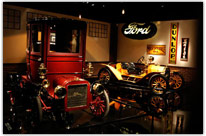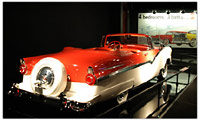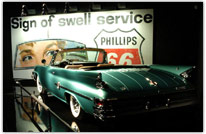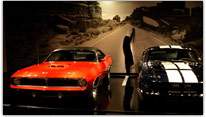The History of The American Automobile
American culture before the broad availability of the automobile was divided into urban dwellers who lived close to work and shopping and traveled mostly on foot, and agrarian communities that depended on the horse and buggy. Large urban areas included business owners and magnates, the wealthy who could access early cars at a high cost. The less affluent agricultural or working class were largely still using the horse drawn wagon for transportation and for doing the hard labor of farming and hauling goods into the second decade of the 1900’s. For those in the latter group, whether you lived on the farm or lived in the city, the car would eventually change your way of life. With the car came the ability to move out of the city, but still maintain your employment there. Suburbia was born! And its impact on reducing backbreaking work on the farm was immeasurable.
In the beginning of America’s automobile history, hundreds of companies found themselves suddenly trying to make the transition from building horse drawn carriages and bicycles to building automobiles in order to satisfy the sudden huge demand in the market. The Industrial Age had brought about process and materials that allowed for the construction of automobiles that would be available to nearly everyone. Companies like Winton, Pierce Arrow, Packard, Duesenberg, and Cord were available to those who could choose the best. Hudson, Oakland, Essex and Studebaker were some of the prominent early affordable cars. None of these marques still exist today, nevertheless they had a great impact on the American auto industry with profound automotive innovations such as front wheel drive, dual overhead cam engines, hydraulic brakes and electric lighting.
 The 1906 Model H Cadillac is the earliest car currently featured in the museum, but it is not the first American car manufactured. Our automotive roots begin with Charles Duryea who was the first American automobile manufacturer, producing 13 gasoline powered cars in 1896. Ransom E. Olds took the next step by mass producing automobiles and creating the assembly line process. In 1901, his assembly line produced 425 horseless carriage cars in a single year. Improvements were made to the assembly line and in 1902 he produced 2,500 curved dash Oldsmobiles. Many credit Henry Ford for the modern assembly line but he improved on the idea by installing conveyer belts and other systems which would reduce his assembly time from a day and a half to 90 minutes per car. Henry Ford neither created the first automobile or the assembly line but his Model T transformed the nation’s way of life by changing our perception of cars from being a luxury item to a necessity and providing an affordable automobile for the masses. Ford revolutionized manufacturing by implementing the eight-hour work day which created a three shift 24 hour day of production, and by doubling employee wages to five dollars a day. Ford’s main competitor was General Motors, which was formed in 1908, initially incorporating only the Buick Motor Company.
The 1906 Model H Cadillac is the earliest car currently featured in the museum, but it is not the first American car manufactured. Our automotive roots begin with Charles Duryea who was the first American automobile manufacturer, producing 13 gasoline powered cars in 1896. Ransom E. Olds took the next step by mass producing automobiles and creating the assembly line process. In 1901, his assembly line produced 425 horseless carriage cars in a single year. Improvements were made to the assembly line and in 1902 he produced 2,500 curved dash Oldsmobiles. Many credit Henry Ford for the modern assembly line but he improved on the idea by installing conveyer belts and other systems which would reduce his assembly time from a day and a half to 90 minutes per car. Henry Ford neither created the first automobile or the assembly line but his Model T transformed the nation’s way of life by changing our perception of cars from being a luxury item to a necessity and providing an affordable automobile for the masses. Ford revolutionized manufacturing by implementing the eight-hour work day which created a three shift 24 hour day of production, and by doubling employee wages to five dollars a day. Ford’s main competitor was General Motors, which was formed in 1908, initially incorporating only the Buick Motor Company.
 Over the next few years GM acquired Olds Motor Company, Fisher Body, Cadillac, Chevrolet and Oakland Motor Car Company, later renamed Pontiac. While Ford and Chevy were manufacturing inexpensive automobiles for the general public, many companies were further developing luxury custom vehicles for the wealthy. Car companies like Cadillac, Packard, Auburn, and Duesenberg built one-of-kind custom vehicles that were the envy of the American public, but only the affluent buyer could afford to own one. The Great Depression stunted the elite car companies and forced many into bankruptcy, while others merged to try to stay solvent. Several companies, like Packard, were forced to offer a mid grade, lower priced automobile to avoid economic failure. World War II halted American automobile production from 1942 to 1946 for the general public and companies remained in business by building aircraft engines and military vehicles.
Over the next few years GM acquired Olds Motor Company, Fisher Body, Cadillac, Chevrolet and Oakland Motor Car Company, later renamed Pontiac. While Ford and Chevy were manufacturing inexpensive automobiles for the general public, many companies were further developing luxury custom vehicles for the wealthy. Car companies like Cadillac, Packard, Auburn, and Duesenberg built one-of-kind custom vehicles that were the envy of the American public, but only the affluent buyer could afford to own one. The Great Depression stunted the elite car companies and forced many into bankruptcy, while others merged to try to stay solvent. Several companies, like Packard, were forced to offer a mid grade, lower priced automobile to avoid economic failure. World War II halted American automobile production from 1942 to 1946 for the general public and companies remained in business by building aircraft engines and military vehicles.
 After World War II – car companies took advantage of the abundance of steel and started manufacturing large, well-appointed and high powered, aerodynamic cars that set trends in design and engineering. The cars of the fifties, trimmed with gleaming chrome inside and out, ignited Detroit’s Golden Age of the automobile. Harley Earl, GM’s chief engineer and designer, can be credited for many of the ornate designs of the 1950’s, incorporating art, science, and engineering to produce works of rolling sculpture. Earl is the father of the Corvette and is credited for the tailfin craze, wrap-around windshield, two-tone paint, integrated trunks and annual styling changes for cars. With rapid market changes in the 1950’s not all manufacturers flourished; companies like Hudson, Nash, Packard, and Studebaker were forced to merge but still could not compete with the output and rapid changes being developed by what would become the Big Three (Ford, Chrysler, & GM) and eventually many smaller manufacturers were forced to stop their assembly lines and close their doors.
After World War II – car companies took advantage of the abundance of steel and started manufacturing large, well-appointed and high powered, aerodynamic cars that set trends in design and engineering. The cars of the fifties, trimmed with gleaming chrome inside and out, ignited Detroit’s Golden Age of the automobile. Harley Earl, GM’s chief engineer and designer, can be credited for many of the ornate designs of the 1950’s, incorporating art, science, and engineering to produce works of rolling sculpture. Earl is the father of the Corvette and is credited for the tailfin craze, wrap-around windshield, two-tone paint, integrated trunks and annual styling changes for cars. With rapid market changes in the 1950’s not all manufacturers flourished; companies like Hudson, Nash, Packard, and Studebaker were forced to merge but still could not compete with the output and rapid changes being developed by what would become the Big Three (Ford, Chrysler, & GM) and eventually many smaller manufacturers were forced to stop their assembly lines and close their doors.
 The 1960’s brought the Muscle Car era, when companies vied for speed by putting V-8 engines into small and midsize cars, giving them startling performance and setting off intense competition between manufacturers to produce the most powerful and extreme machine. By the early 1970’s the muscle car had mostly died due to rising fuel costs, safety concerns and federally mandated emissions controls forcing manufacturers to navigate a difficult set of parameters to continue making performance cars. Car companies would even lower their published horsepower to fit into safety and insurance guidelines, while making it known unofficially that their cars were much more powerful in reality.
The 1960’s brought the Muscle Car era, when companies vied for speed by putting V-8 engines into small and midsize cars, giving them startling performance and setting off intense competition between manufacturers to produce the most powerful and extreme machine. By the early 1970’s the muscle car had mostly died due to rising fuel costs, safety concerns and federally mandated emissions controls forcing manufacturers to navigate a difficult set of parameters to continue making performance cars. Car companies would even lower their published horsepower to fit into safety and insurance guidelines, while making it known unofficially that their cars were much more powerful in reality.
The 1973 oil crisis quadrupled the price of oil and severely impacted transportation in the U.S. – the national speed limit was lowered, and year round daylight savings was implemented. Americans became more aware of their cars’ gas mileage and started buying fuel-efficient Japanese and European cars. Ford, GM. and Chrysler answered the crisis by building more fuel efficient mid size cars to compete in this new market. During the 1950’s American cars were re-designed aesthetically every year but not technically or mechanically updated as often. This continued trend made it more difficult to catch up as the market changed rapidly. American automobile companies that once created unique and powerful cars were now being forced to learn a new game due to rising fuel costs, fierce competition, and limited resources. They would now have to produce similarly sized and styled, fuel efficient, and limited performance cars more like those from foreign competitors that were suddenly prominent on our roads. The slow learning curve and reluctance to follow instead of lead placed the American car of the 1980’s at a disadvantage even in its home market. The tide began to turn in the next decade and American cars are now some of the most stylish, powerful and technologically advanced; we’ve come full circle.
In the more than a century spent with the American automobile it has become the center of American culture and lifestyle. As concerns about the high gas prices, effects of pollution and green house gases increase, internal combustion engine cars may be replaced with an alternative fuel source such as solar, electric, hybrid, or hydrogen fuel cell power. The car will have many changes in the future but it will remain an icon of American society and culture that is treasured by all.
